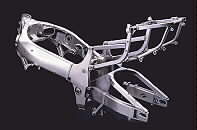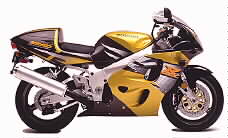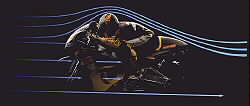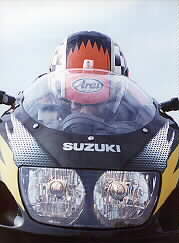Motorsports Racing News & Blog Articles
Church of MO: Middleweight Messiah: 1996 GSXR-750
One-quarter century ago, MO was just getting off the ground but had not yet retracted its landing gear. Even then, luckily, Suzuki GSX-R750s were expendable enough that Suzuki loaned us one for review. Which was kind of a big deal, because MO’s terrible twos coincided with the year Suzuki blew out all the stops to create a much lighter, much more compact, and much more powerful 1996 GSX-R750. The race to build racebikes for the street was on.
Middleweight Messiah: Riding The GSXR-750

The massively light frame narrows between the rider’s knees like the old perimeter frame never could. Swing your leg over the huge, ugly tailpiece and the first thing you notice is size, or lack of it. This 750 is 600 sized, and 600 light. The cockpit is spartan; the ignition key plugs directly into the top triple clamp, and instruments nestle in the nose of the fairing, almost out of sight through the low windscreen. Partitioned inside the speedometer, an LCD panel tells total mileage or either of two trip miles. Inside the tachometer, a coolant temperature panel distracts attention from the astronomical 13,5000 rpm redline.
Secret of the Gisxer’s new lightweight appeal is the twin-beam aluminum chassis, made of extruded, sheet, forged and cast pieces of aluminum, welded together and combined with a lightweight but strong swing arm to give the straightest, strongest possible path from 24 degree steering head to a six inch rear wheel rim.

The frame doubles as a conduit for twin ram-air tunnels that feed airstream-pressurized air direct from fairing scoops to the 39mm electronically controlled carburetors.
The Suzuki’s brain (the ignition CPU) controls the lift of the carburetor’s new beveled slides by regulating the pressure above the diaphragms. The combination of ram air and electronics allows bigger carburetors (more high end power) without bogging the engine at low speed.
Dynos aren’t the real world, but on the highway, that power hits as a huge wheelie in first gear if you yank the throttle hard, and keeps right on going until it peaks around 11,000 rpm. Down in the engine department Suzuki’s designers have lightened everything in sight, and then some.
The new engine is a full 20 pounds lighter than the older model, and 30mm thinner, contributing to the 600-class feel. Some weight shaving is due to new nickel-silicon coatings that replace heavy cylinder liners, and contribute most to the narrow engine. Most components lost weight.
“About the only thing Suzuki hasn’t lightened is the rider’s butt.”

Throw a leg over this bike, and your butt thinks you’re on a 600. It’s much smaller, and more comfortable than any previous GSXR. The footpegs are still up high, but the fork-mounted clip-ons put less weight on the wrists than before. The twin beam frame narrows comfortably between the rider’s legs. The bike is so small, the instruments so close, that it’s only possible to see the speedometer by looking through the windshield from above. That’s until you get up to serious speed, and start taking advantage of the chin cutout in the gas tank…

And speed is where the bike excels. The rock-solid chassis, superb brakes and seamless power supply make for absolute confidence at almost any speed. No steering damper is fitted: None is needed. Even with a monstrously steep steering head angle (the same as Kevin Schwantz’s GP bike of only a few years ago, a bike Suzuki drew on extensively in the new design). Stability is impressive, at any speed.
“Suzuki’s engineers must have spent aeons of time in the wind tunnel…”
The Showa suspension units are excellent at race speeds but soak up pavement irregularities at street speeds with comfortable compliance. Suzuki’s engineers must have spent aeons of time in the wind tunnel, judging by the lengths to which they’ve gone with the new plastic bodywork.
The bellypan extends to within an inch of the rear wheel, while the front of the fairing almost extends to meet the front wheel. Decals on the gold and brown model ape Honda’s much ballyhooed CBR900RR fairing holes.
Real holes exist in the lower fairing, allowing air circulation around the crankcase. Cooling is one of the Suzuki’s weak points.
The rev-counter mounted temperature gauge climbs quickly to 213 degrees (Fahrenheit) in town traffic. As the coolant system is pressurized, it’s safe to a few more degrees above the boiling point of water, but it’s an unnerving feeling to watch the water come to the boil…a single fan, in the right side of the radiator, cuts in when the mercury soars, but this isn’t the bike we’d choose for Phoenix in July.

Instead, this may be the bike many riders will choose in many other parts of the country. The power is simply seamless and linear, starting way down in the rpm basement and continuing up past the 12th floor. Get the rev-counter needle hovering around 10 and the power happens like a locomotive. By 13,000 rpm the engine is shrieking and it’s way past time for a gear change, but the lightweight flier is still pushing hard enough to plant your backside against the seat hump, all the way to the 13,500 rpm limit.
The gearchange is quick and sure, with no chance of a false neutral, and you’ll need to take advantage of it to keep the motor on the boil. We didn’t get the chance to match the GSXR against Honda’s CBR900RR, but that contest would be close. Though down on power compared to the RR, the ‘zuki plainly has the edge on handling, and Honda’s CBR design team must be sweating over their abacuses.
Complementing the power plant are the superb brakes. They’re almost too powerful. The twin 320mm discs are grabbed by six-piston calipers for a bite that will squeal the front tire with ease, and stop time after time without fade.
You’ll know when to slow down, because the Suzuki is the sportbike with the best mirrors. When that Black and White slunk up behind, we shut down in plenty of time. The CBR 600 F3 rider, with his rearview dominated by his elbows, was not so lucky.
Yet another customer in line for a new GSXR.
Impressions:
1. Andy Saunders, Editor * * * * 1/2
A few years ago, when Suzuki introduced the GSXR 600, they built a 600 with the weight and size of a 750. Now they’ve built a 750 with the weight and size of a 600, and 900 class power. That’s what’s called getting it right. You can feel it’s right, the instant you sit in the saddle. But why are you still reading all this drivel? If you want one, better get your finely tuned wallet along to the dealers right now, ready for some serious weight reduction.
2. Brent Plummer, Editor-in-Chief * * * * *
Smokin’ awesome! I gotta have one, and if you don’t want to spend your days watching 1996 GSXR750 owners’ tailights recede into the distance, or — if racing is your thing — getting humilitatingly smoked at the track, you do too. For a production bike, it’s flawless. Heck, for a Supersport racer, it’s awesome. When we ran it against Chuck Graves’ 1995 class-leading Suzuki Cup racer, it made the same amount of horsepower. And Graves’ racer is built to the book (and probably a bit beyond) and in box-stock form, ours handles and stops better. What more could you want?
3. Mike Franklin, Managing Editor. * * * * *
I want one! But then I say that about a lot of new bikes — bikes that tend to redefine the term “sportbike.” It is rare when a machine comes along that can do everything it promises to do, and does it all remarkably well. The new Gixer is one of that rare breed. Other bikes make more power, one or two can turn as well, but none that I’ve ridden can touch the combination of power and finesse that the Suzuki dishes out at a surprisingly affordable price. For just $8999 you can buy a bike that is closer to Kevin Schwantz’s Grand Prix machine than any four-stroke has a right to be. With the 1996 Suzuki GSXR750 being this good, I can’t wait for the next bike that makes me say “I want one,” but I’m afraid it might be a long while coming.
4. Todd Canavan, Associate Editor * * * * *
The GSXR is the best production bike I have ever swung a leg over. It is light, fast, nimble and stable, qualities that have rarely co-existed in one machine. This bike clearly ups the ante for 750 class competition, and Suzuki is holding all of the cards. I have only one reservation about this bike: It is too much fun to accelerate, a bad thing when the density of men in blue is as high as it is here in Los Angeles. Okay, I got another damn speeding ticket! The bike still rocks, but is it too much for the street?
 |
| 1996 Max Hp: 117.1@11,750 — 1996 Max Tq: 57.0@9,750 1995 Max Hp: 92.9@10,500 — 1995 Max Tq: 49.3@9,500 |
|
|
The post Church of MO: Middleweight Messiah: 1996 GSXR-750 appeared first on Motorcycle.com.
Copyright
© Motorcycle.com

